Principles of Health Informatics
VerifiedAdded on 2022/12/28
|11
|3469
|25
AI Summary
This document discusses the principles of health informatics and explores the capabilities, applications, and benefits of artificial intelligence in healthcare. It also examines the barriers to adopting AI in healthcare and the ethical challenges it presents. The document provides insights into the impact of AI on healthcare delivery and the social challenges associated with AI in healthcare.
Contribute Materials
Your contribution can guide someone’s learning journey. Share your
documents today.
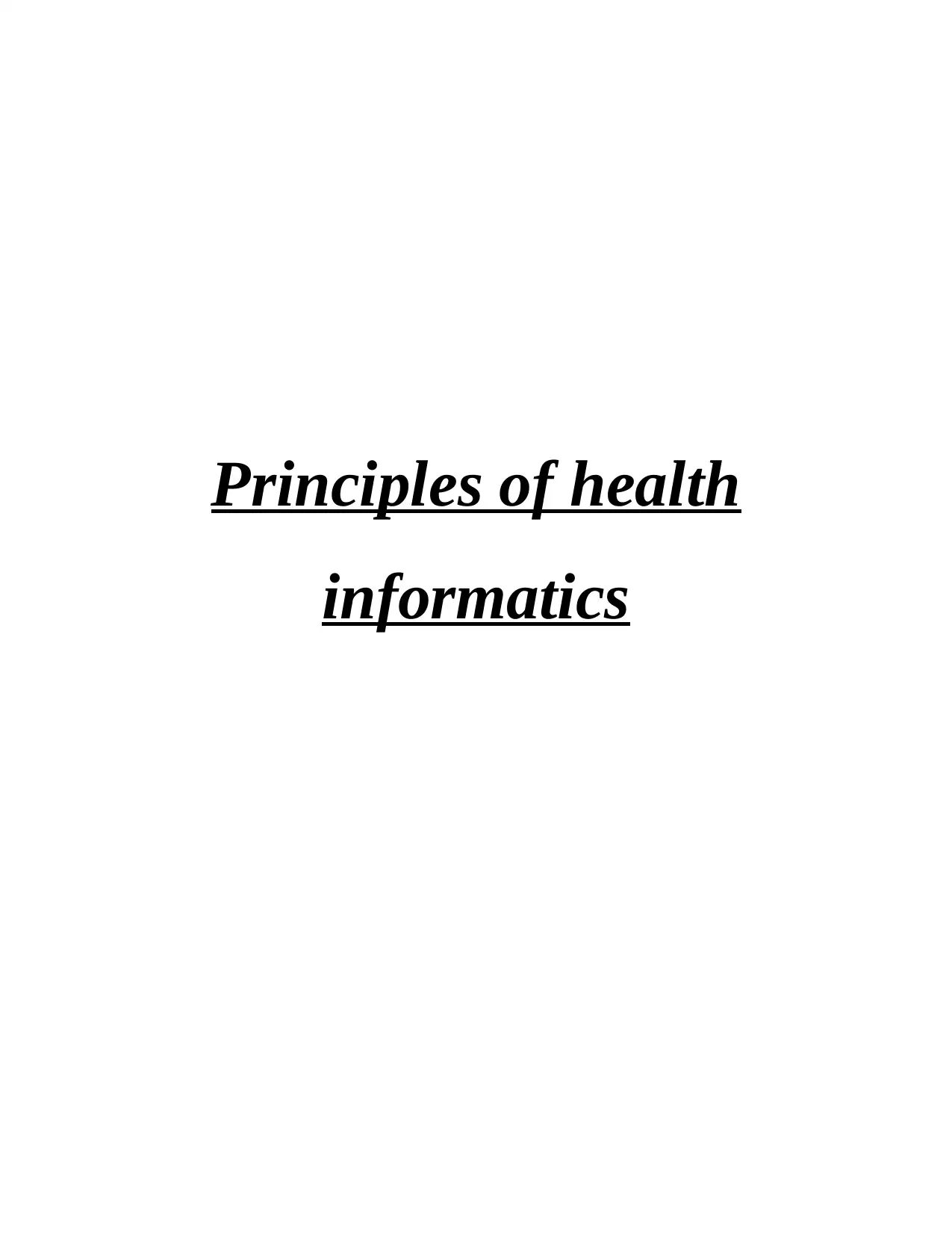
Principles of health
informatics
informatics
Secure Best Marks with AI Grader
Need help grading? Try our AI Grader for instant feedback on your assignments.
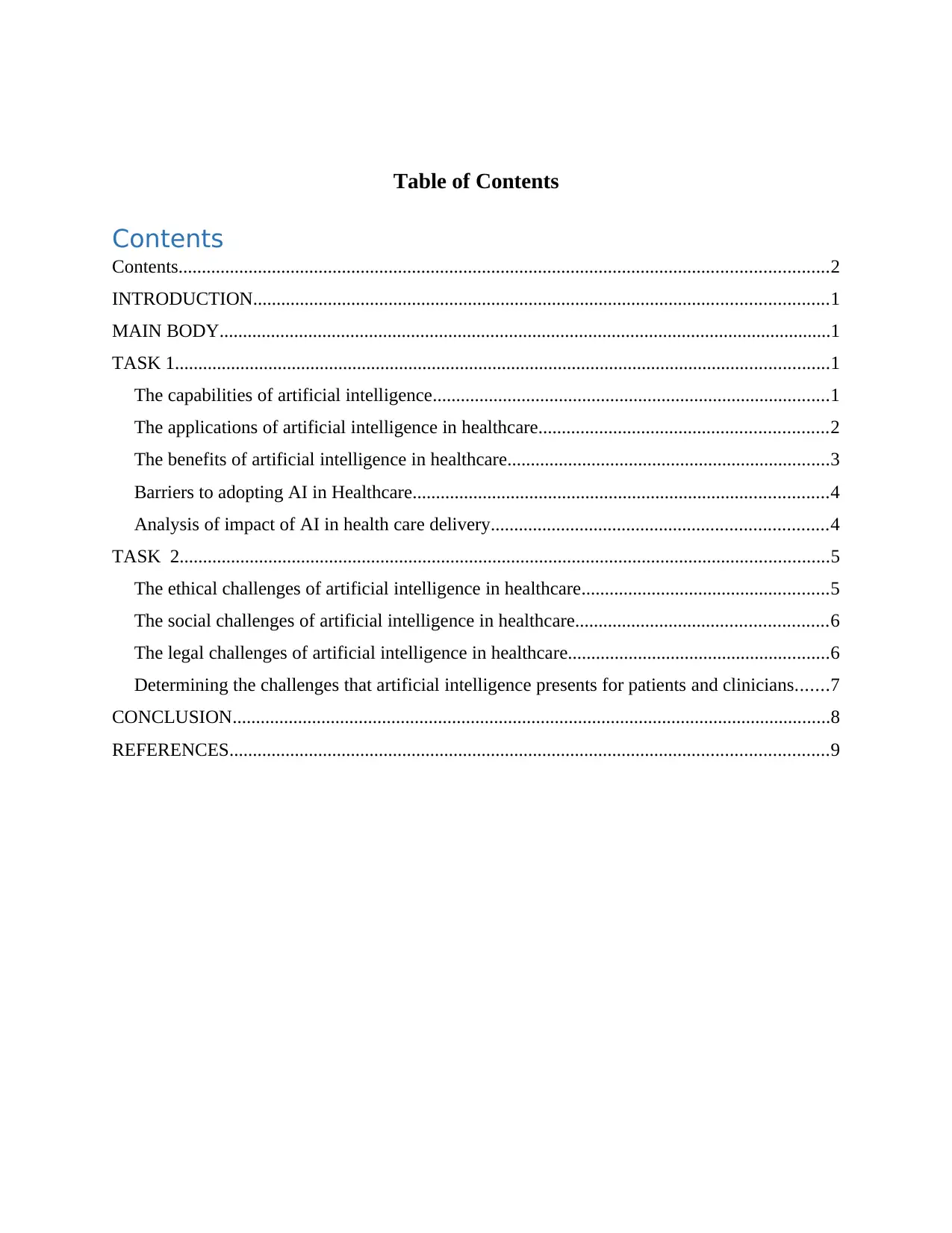
Table of Contents
Contents
Contents...........................................................................................................................................2
INTRODUCTION...........................................................................................................................1
MAIN BODY...................................................................................................................................1
TASK 1............................................................................................................................................1
The capabilities of artificial intelligence.....................................................................................1
The applications of artificial intelligence in healthcare..............................................................2
The benefits of artificial intelligence in healthcare.....................................................................3
Barriers to adopting AI in Healthcare.........................................................................................4
Analysis of impact of AI in health care delivery........................................................................4
TASK 2...........................................................................................................................................5
The ethical challenges of artificial intelligence in healthcare.....................................................5
The social challenges of artificial intelligence in healthcare......................................................6
The legal challenges of artificial intelligence in healthcare........................................................6
Determining the challenges that artificial intelligence presents for patients and clinicians.......7
CONCLUSION................................................................................................................................8
REFERENCES................................................................................................................................9
Contents
Contents...........................................................................................................................................2
INTRODUCTION...........................................................................................................................1
MAIN BODY...................................................................................................................................1
TASK 1............................................................................................................................................1
The capabilities of artificial intelligence.....................................................................................1
The applications of artificial intelligence in healthcare..............................................................2
The benefits of artificial intelligence in healthcare.....................................................................3
Barriers to adopting AI in Healthcare.........................................................................................4
Analysis of impact of AI in health care delivery........................................................................4
TASK 2...........................................................................................................................................5
The ethical challenges of artificial intelligence in healthcare.....................................................5
The social challenges of artificial intelligence in healthcare......................................................6
The legal challenges of artificial intelligence in healthcare........................................................6
Determining the challenges that artificial intelligence presents for patients and clinicians.......7
CONCLUSION................................................................................................................................8
REFERENCES................................................................................................................................9
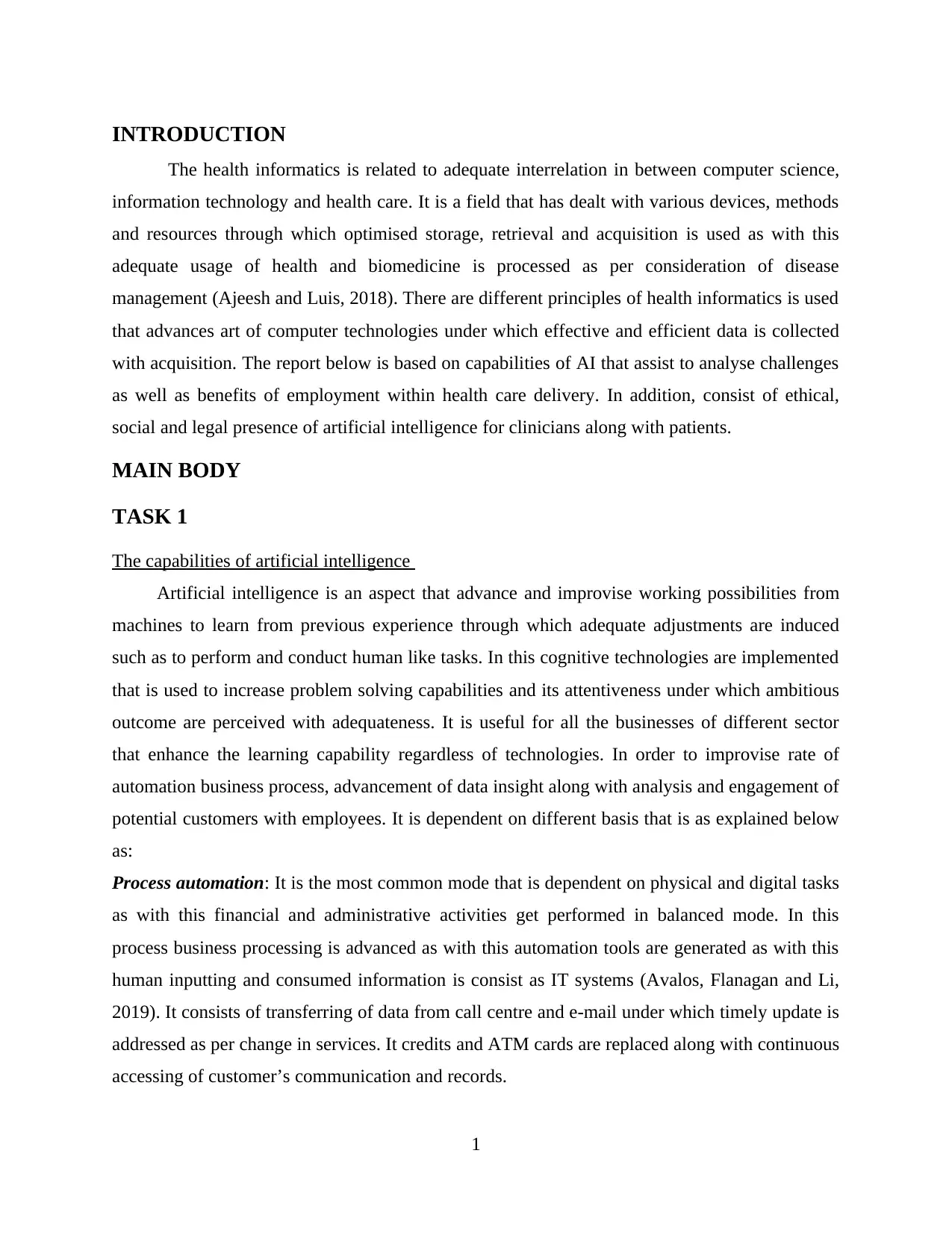
INTRODUCTION
The health informatics is related to adequate interrelation in between computer science,
information technology and health care. It is a field that has dealt with various devices, methods
and resources through which optimised storage, retrieval and acquisition is used as with this
adequate usage of health and biomedicine is processed as per consideration of disease
management (Ajeesh and Luis, 2018). There are different principles of health informatics is used
that advances art of computer technologies under which effective and efficient data is collected
with acquisition. The report below is based on capabilities of AI that assist to analyse challenges
as well as benefits of employment within health care delivery. In addition, consist of ethical,
social and legal presence of artificial intelligence for clinicians along with patients.
MAIN BODY
TASK 1
The capabilities of artificial intelligence
Artificial intelligence is an aspect that advance and improvise working possibilities from
machines to learn from previous experience through which adequate adjustments are induced
such as to perform and conduct human like tasks. In this cognitive technologies are implemented
that is used to increase problem solving capabilities and its attentiveness under which ambitious
outcome are perceived with adequateness. It is useful for all the businesses of different sector
that enhance the learning capability regardless of technologies. In order to improvise rate of
automation business process, advancement of data insight along with analysis and engagement of
potential customers with employees. It is dependent on different basis that is as explained below
as:
Process automation: It is the most common mode that is dependent on physical and digital tasks
as with this financial and administrative activities get performed in balanced mode. In this
process business processing is advanced as with this automation tools are generated as with this
human inputting and consumed information is consist as IT systems (Avalos, Flanagan and Li,
2019). It consists of transferring of data from call centre and e-mail under which timely update is
addressed as per change in services. It credits and ATM cards are replaced along with continuous
accessing of customer’s communication and records.
1
The health informatics is related to adequate interrelation in between computer science,
information technology and health care. It is a field that has dealt with various devices, methods
and resources through which optimised storage, retrieval and acquisition is used as with this
adequate usage of health and biomedicine is processed as per consideration of disease
management (Ajeesh and Luis, 2018). There are different principles of health informatics is used
that advances art of computer technologies under which effective and efficient data is collected
with acquisition. The report below is based on capabilities of AI that assist to analyse challenges
as well as benefits of employment within health care delivery. In addition, consist of ethical,
social and legal presence of artificial intelligence for clinicians along with patients.
MAIN BODY
TASK 1
The capabilities of artificial intelligence
Artificial intelligence is an aspect that advance and improvise working possibilities from
machines to learn from previous experience through which adequate adjustments are induced
such as to perform and conduct human like tasks. In this cognitive technologies are implemented
that is used to increase problem solving capabilities and its attentiveness under which ambitious
outcome are perceived with adequateness. It is useful for all the businesses of different sector
that enhance the learning capability regardless of technologies. In order to improvise rate of
automation business process, advancement of data insight along with analysis and engagement of
potential customers with employees. It is dependent on different basis that is as explained below
as:
Process automation: It is the most common mode that is dependent on physical and digital tasks
as with this financial and administrative activities get performed in balanced mode. In this
process business processing is advanced as with this automation tools are generated as with this
human inputting and consumed information is consist as IT systems (Avalos, Flanagan and Li,
2019). It consists of transferring of data from call centre and e-mail under which timely update is
addressed as per change in services. It credits and ATM cards are replaced along with continuous
accessing of customer’s communication and records.
1
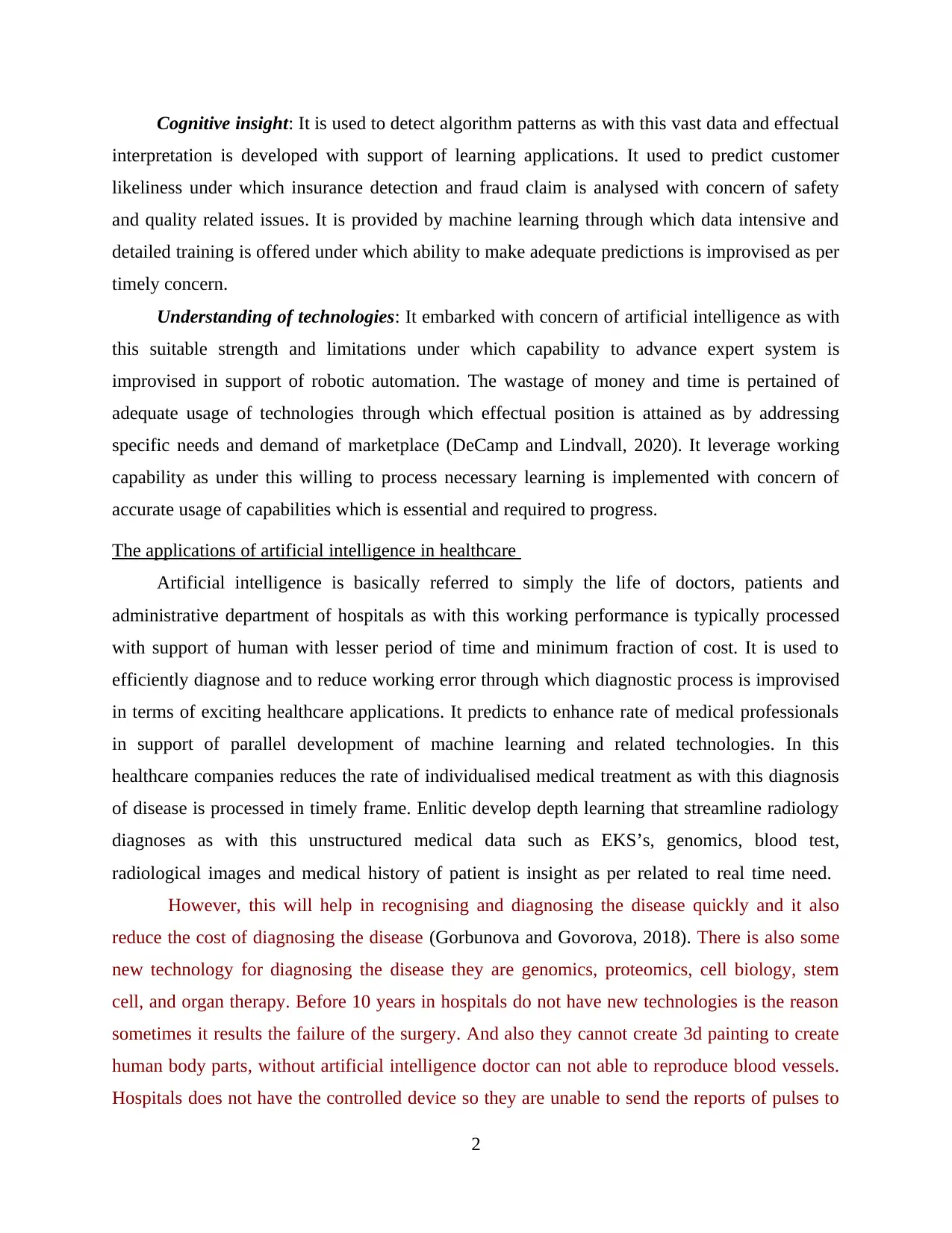
Cognitive insight: It is used to detect algorithm patterns as with this vast data and effectual
interpretation is developed with support of learning applications. It used to predict customer
likeliness under which insurance detection and fraud claim is analysed with concern of safety
and quality related issues. It is provided by machine learning through which data intensive and
detailed training is offered under which ability to make adequate predictions is improvised as per
timely concern.
Understanding of technologies: It embarked with concern of artificial intelligence as with
this suitable strength and limitations under which capability to advance expert system is
improvised in support of robotic automation. The wastage of money and time is pertained of
adequate usage of technologies through which effectual position is attained as by addressing
specific needs and demand of marketplace (DeCamp and Lindvall, 2020). It leverage working
capability as under this willing to process necessary learning is implemented with concern of
accurate usage of capabilities which is essential and required to progress.
The applications of artificial intelligence in healthcare
Artificial intelligence is basically referred to simply the life of doctors, patients and
administrative department of hospitals as with this working performance is typically processed
with support of human with lesser period of time and minimum fraction of cost. It is used to
efficiently diagnose and to reduce working error through which diagnostic process is improvised
in terms of exciting healthcare applications. It predicts to enhance rate of medical professionals
in support of parallel development of machine learning and related technologies. In this
healthcare companies reduces the rate of individualised medical treatment as with this diagnosis
of disease is processed in timely frame. Enlitic develop depth learning that streamline radiology
diagnoses as with this unstructured medical data such as EKS’s, genomics, blood test,
radiological images and medical history of patient is insight as per related to real time need.
However, this will help in recognising and diagnosing the disease quickly and it also
reduce the cost of diagnosing the disease (Gorbunovа and Govorova, 2018). There is also some
new technology for diagnosing the disease they are genomics, proteomics, cell biology, stem
cell, and organ therapy. Before 10 years in hospitals do not have new technologies is the reason
sometimes it results the failure of the surgery. And also they cannot create 3d painting to create
human body parts, without artificial intelligence doctor can not able to reproduce blood vessels.
Hospitals does not have the controlled device so they are unable to send the reports of pulses to
2
interpretation is developed with support of learning applications. It used to predict customer
likeliness under which insurance detection and fraud claim is analysed with concern of safety
and quality related issues. It is provided by machine learning through which data intensive and
detailed training is offered under which ability to make adequate predictions is improvised as per
timely concern.
Understanding of technologies: It embarked with concern of artificial intelligence as with
this suitable strength and limitations under which capability to advance expert system is
improvised in support of robotic automation. The wastage of money and time is pertained of
adequate usage of technologies through which effectual position is attained as by addressing
specific needs and demand of marketplace (DeCamp and Lindvall, 2020). It leverage working
capability as under this willing to process necessary learning is implemented with concern of
accurate usage of capabilities which is essential and required to progress.
The applications of artificial intelligence in healthcare
Artificial intelligence is basically referred to simply the life of doctors, patients and
administrative department of hospitals as with this working performance is typically processed
with support of human with lesser period of time and minimum fraction of cost. It is used to
efficiently diagnose and to reduce working error through which diagnostic process is improvised
in terms of exciting healthcare applications. It predicts to enhance rate of medical professionals
in support of parallel development of machine learning and related technologies. In this
healthcare companies reduces the rate of individualised medical treatment as with this diagnosis
of disease is processed in timely frame. Enlitic develop depth learning that streamline radiology
diagnoses as with this unstructured medical data such as EKS’s, genomics, blood test,
radiological images and medical history of patient is insight as per related to real time need.
However, this will help in recognising and diagnosing the disease quickly and it also
reduce the cost of diagnosing the disease (Gorbunovа and Govorova, 2018). There is also some
new technology for diagnosing the disease they are genomics, proteomics, cell biology, stem
cell, and organ therapy. Before 10 years in hospitals do not have new technologies is the reason
sometimes it results the failure of the surgery. And also they cannot create 3d painting to create
human body parts, without artificial intelligence doctor can not able to reproduce blood vessels.
Hospitals does not have the controlled device so they are unable to send the reports of pulses to
2
Secure Best Marks with AI Grader
Need help grading? Try our AI Grader for instant feedback on your assignments.
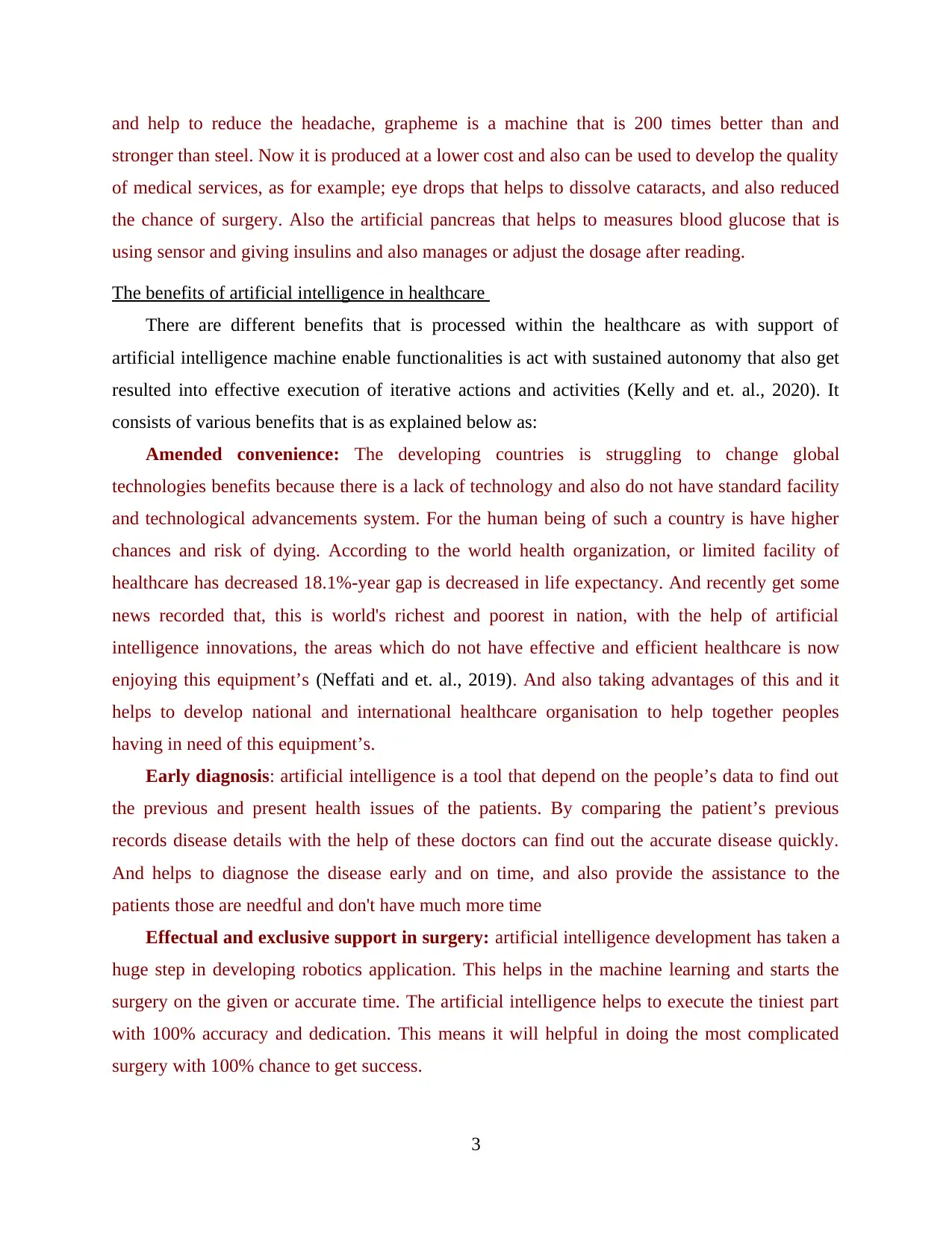
and help to reduce the headache, grapheme is a machine that is 200 times better than and
stronger than steel. Now it is produced at a lower cost and also can be used to develop the quality
of medical services, as for example; eye drops that helps to dissolve cataracts, and also reduced
the chance of surgery. Also the artificial pancreas that helps to measures blood glucose that is
using sensor and giving insulins and also manages or adjust the dosage after reading.
The benefits of artificial intelligence in healthcare
There are different benefits that is processed within the healthcare as with support of
artificial intelligence machine enable functionalities is act with sustained autonomy that also get
resulted into effective execution of iterative actions and activities (Kelly and et. al., 2020). It
consists of various benefits that is as explained below as:
Amended convenience: The developing countries is struggling to change global
technologies benefits because there is a lack of technology and also do not have standard facility
and technological advancements system. For the human being of such a country is have higher
chances and risk of dying. According to the world health organization, or limited facility of
healthcare has decreased 18.1%-year gap is decreased in life expectancy. And recently get some
news recorded that, this is world's richest and poorest in nation, with the help of artificial
intelligence innovations, the areas which do not have effective and efficient healthcare is now
enjoying this equipment’s (Neffati and et. al., 2019). And also taking advantages of this and it
helps to develop national and international healthcare organisation to help together peoples
having in need of this equipment’s.
Early diagnosis: artificial intelligence is a tool that depend on the people’s data to find out
the previous and present health issues of the patients. By comparing the patient’s previous
records disease details with the help of these doctors can find out the accurate disease quickly.
And helps to diagnose the disease early and on time, and also provide the assistance to the
patients those are needful and don't have much more time
Effectual and exclusive support in surgery: artificial intelligence development has taken a
huge step in developing robotics application. This helps in the machine learning and starts the
surgery on the given or accurate time. The artificial intelligence helps to execute the tiniest part
with 100% accuracy and dedication. This means it will helpful in doing the most complicated
surgery with 100% chance to get success.
3
stronger than steel. Now it is produced at a lower cost and also can be used to develop the quality
of medical services, as for example; eye drops that helps to dissolve cataracts, and also reduced
the chance of surgery. Also the artificial pancreas that helps to measures blood glucose that is
using sensor and giving insulins and also manages or adjust the dosage after reading.
The benefits of artificial intelligence in healthcare
There are different benefits that is processed within the healthcare as with support of
artificial intelligence machine enable functionalities is act with sustained autonomy that also get
resulted into effective execution of iterative actions and activities (Kelly and et. al., 2020). It
consists of various benefits that is as explained below as:
Amended convenience: The developing countries is struggling to change global
technologies benefits because there is a lack of technology and also do not have standard facility
and technological advancements system. For the human being of such a country is have higher
chances and risk of dying. According to the world health organization, or limited facility of
healthcare has decreased 18.1%-year gap is decreased in life expectancy. And recently get some
news recorded that, this is world's richest and poorest in nation, with the help of artificial
intelligence innovations, the areas which do not have effective and efficient healthcare is now
enjoying this equipment’s (Neffati and et. al., 2019). And also taking advantages of this and it
helps to develop national and international healthcare organisation to help together peoples
having in need of this equipment’s.
Early diagnosis: artificial intelligence is a tool that depend on the people’s data to find out
the previous and present health issues of the patients. By comparing the patient’s previous
records disease details with the help of these doctors can find out the accurate disease quickly.
And helps to diagnose the disease early and on time, and also provide the assistance to the
patients those are needful and don't have much more time
Effectual and exclusive support in surgery: artificial intelligence development has taken a
huge step in developing robotics application. This helps in the machine learning and starts the
surgery on the given or accurate time. The artificial intelligence helps to execute the tiniest part
with 100% accuracy and dedication. This means it will helpful in doing the most complicated
surgery with 100% chance to get success.
3
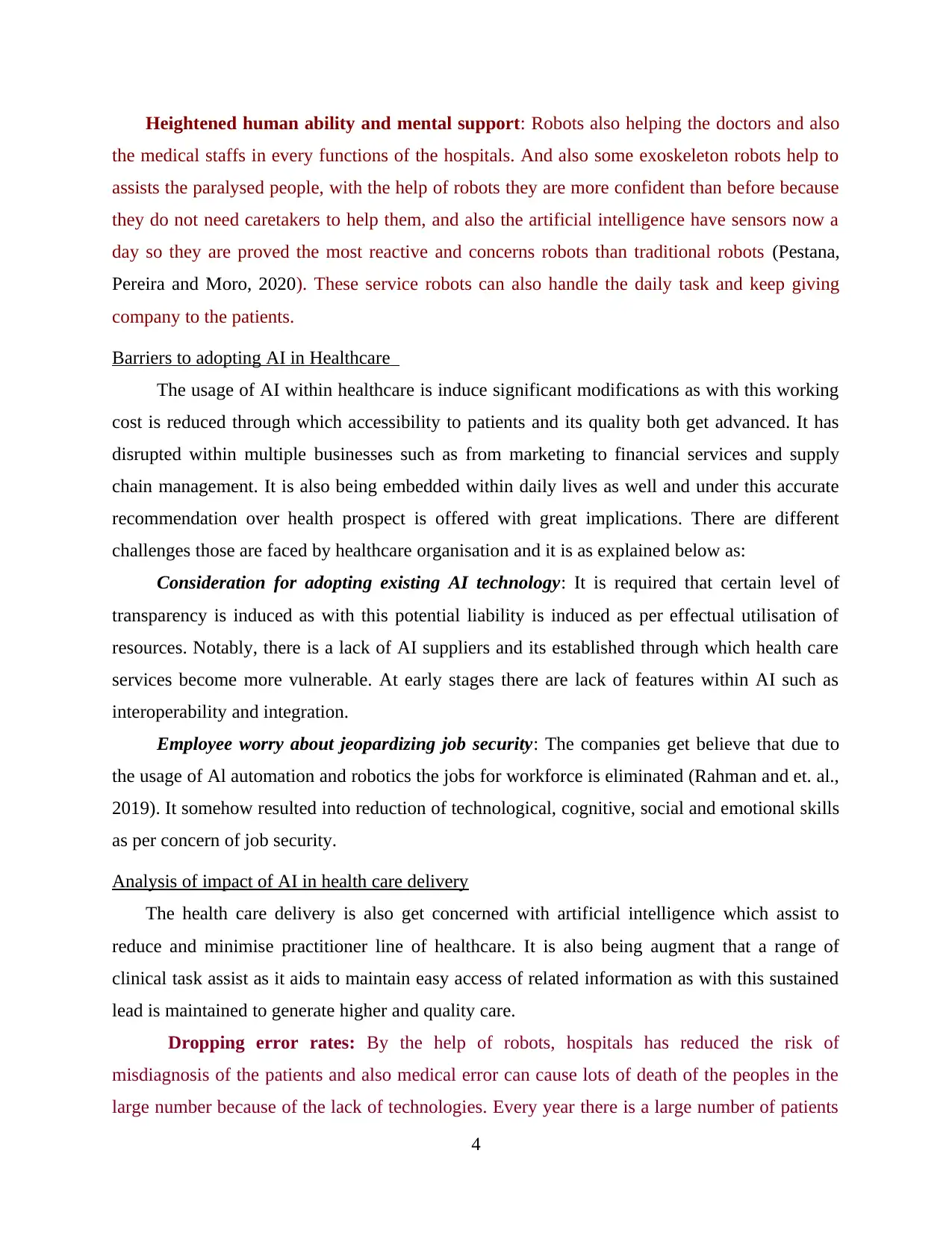
Heightened human ability and mental support: Robots also helping the doctors and also
the medical staffs in every functions of the hospitals. And also some exoskeleton robots help to
assists the paralysed people, with the help of robots they are more confident than before because
they do not need caretakers to help them, and also the artificial intelligence have sensors now a
day so they are proved the most reactive and concerns robots than traditional robots (Pestana,
Pereira and Moro, 2020). These service robots can also handle the daily task and keep giving
company to the patients.
Barriers to adopting AI in Healthcare
The usage of AI within healthcare is induce significant modifications as with this working
cost is reduced through which accessibility to patients and its quality both get advanced. It has
disrupted within multiple businesses such as from marketing to financial services and supply
chain management. It is also being embedded within daily lives as well and under this accurate
recommendation over health prospect is offered with great implications. There are different
challenges those are faced by healthcare organisation and it is as explained below as:
Consideration for adopting existing AI technology: It is required that certain level of
transparency is induced as with this potential liability is induced as per effectual utilisation of
resources. Notably, there is a lack of AI suppliers and its established through which health care
services become more vulnerable. At early stages there are lack of features within AI such as
interoperability and integration.
Employee worry about jeopardizing job security: The companies get believe that due to
the usage of Al automation and robotics the jobs for workforce is eliminated (Rahman and et. al.,
2019). It somehow resulted into reduction of technological, cognitive, social and emotional skills
as per concern of job security.
Analysis of impact of AI in health care delivery
The health care delivery is also get concerned with artificial intelligence which assist to
reduce and minimise practitioner line of healthcare. It is also being augment that a range of
clinical task assist as it aids to maintain easy access of related information as with this sustained
lead is maintained to generate higher and quality care.
Dropping error rates: By the help of robots, hospitals has reduced the risk of
misdiagnosis of the patients and also medical error can cause lots of death of the peoples in the
large number because of the lack of technologies. Every year there is a large number of patients
4
the medical staffs in every functions of the hospitals. And also some exoskeleton robots help to
assists the paralysed people, with the help of robots they are more confident than before because
they do not need caretakers to help them, and also the artificial intelligence have sensors now a
day so they are proved the most reactive and concerns robots than traditional robots (Pestana,
Pereira and Moro, 2020). These service robots can also handle the daily task and keep giving
company to the patients.
Barriers to adopting AI in Healthcare
The usage of AI within healthcare is induce significant modifications as with this working
cost is reduced through which accessibility to patients and its quality both get advanced. It has
disrupted within multiple businesses such as from marketing to financial services and supply
chain management. It is also being embedded within daily lives as well and under this accurate
recommendation over health prospect is offered with great implications. There are different
challenges those are faced by healthcare organisation and it is as explained below as:
Consideration for adopting existing AI technology: It is required that certain level of
transparency is induced as with this potential liability is induced as per effectual utilisation of
resources. Notably, there is a lack of AI suppliers and its established through which health care
services become more vulnerable. At early stages there are lack of features within AI such as
interoperability and integration.
Employee worry about jeopardizing job security: The companies get believe that due to
the usage of Al automation and robotics the jobs for workforce is eliminated (Rahman and et. al.,
2019). It somehow resulted into reduction of technological, cognitive, social and emotional skills
as per concern of job security.
Analysis of impact of AI in health care delivery
The health care delivery is also get concerned with artificial intelligence which assist to
reduce and minimise practitioner line of healthcare. It is also being augment that a range of
clinical task assist as it aids to maintain easy access of related information as with this sustained
lead is maintained to generate higher and quality care.
Dropping error rates: By the help of robots, hospitals has reduced the risk of
misdiagnosis of the patients and also medical error can cause lots of death of the peoples in the
large number because of the lack of technologies. Every year there is a large number of patients
4
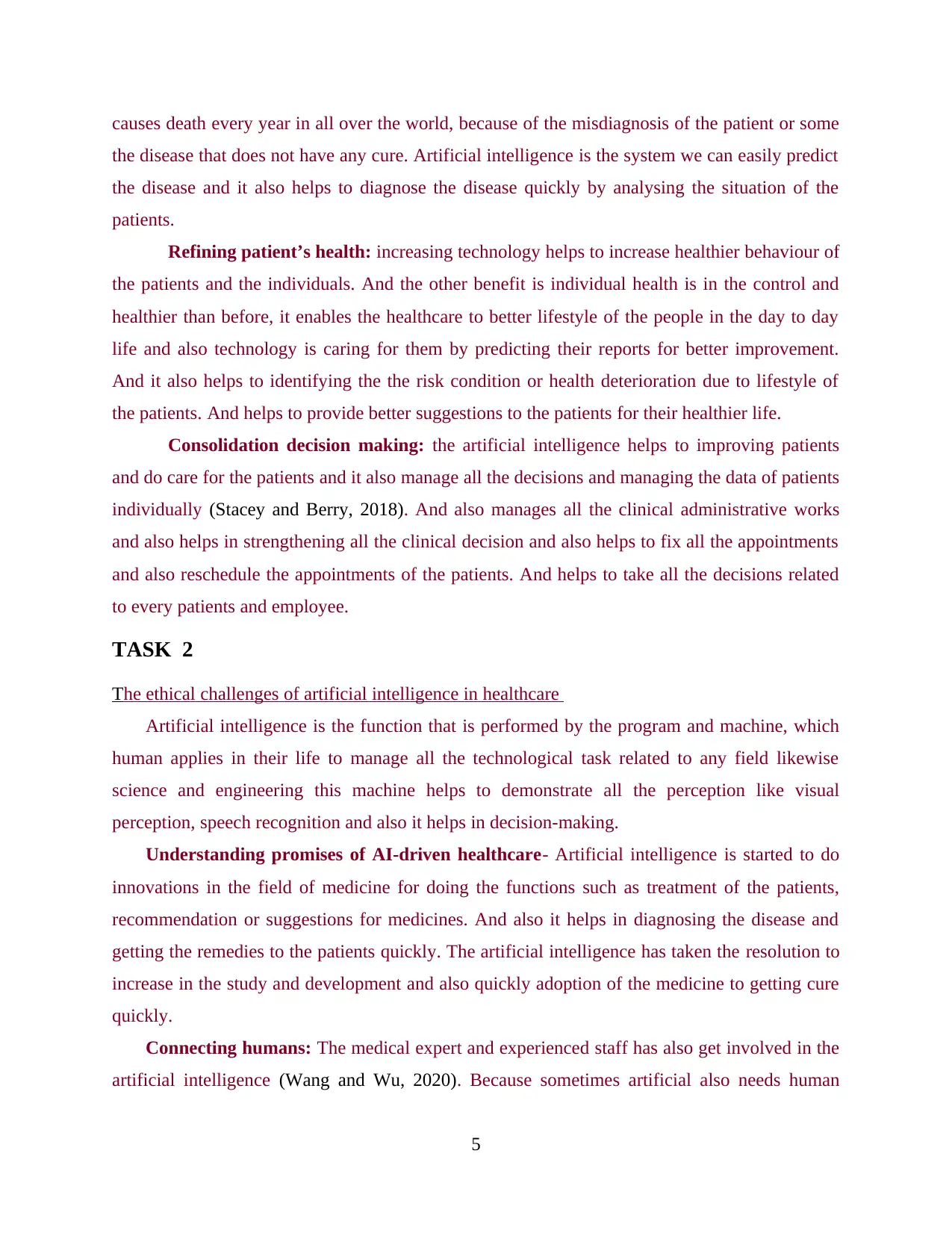
causes death every year in all over the world, because of the misdiagnosis of the patient or some
the disease that does not have any cure. Artificial intelligence is the system we can easily predict
the disease and it also helps to diagnose the disease quickly by analysing the situation of the
patients.
Refining patient’s health: increasing technology helps to increase healthier behaviour of
the patients and the individuals. And the other benefit is individual health is in the control and
healthier than before, it enables the healthcare to better lifestyle of the people in the day to day
life and also technology is caring for them by predicting their reports for better improvement.
And it also helps to identifying the the risk condition or health deterioration due to lifestyle of
the patients. And helps to provide better suggestions to the patients for their healthier life.
Consolidation decision making: the artificial intelligence helps to improving patients
and do care for the patients and it also manage all the decisions and managing the data of patients
individually (Stacey and Berry, 2018). And also manages all the clinical administrative works
and also helps in strengthening all the clinical decision and also helps to fix all the appointments
and also reschedule the appointments of the patients. And helps to take all the decisions related
to every patients and employee.
TASK 2
The ethical challenges of artificial intelligence in healthcare
Artificial intelligence is the function that is performed by the program and machine, which
human applies in their life to manage all the technological task related to any field likewise
science and engineering this machine helps to demonstrate all the perception like visual
perception, speech recognition and also it helps in decision-making.
Understanding promises of AI-driven healthcare- Artificial intelligence is started to do
innovations in the field of medicine for doing the functions such as treatment of the patients,
recommendation or suggestions for medicines. And also it helps in diagnosing the disease and
getting the remedies to the patients quickly. The artificial intelligence has taken the resolution to
increase in the study and development and also quickly adoption of the medicine to getting cure
quickly.
Connecting humans: The medical expert and experienced staff has also get involved in the
artificial intelligence (Wang and Wu, 2020). Because sometimes artificial also needs human
5
the disease that does not have any cure. Artificial intelligence is the system we can easily predict
the disease and it also helps to diagnose the disease quickly by analysing the situation of the
patients.
Refining patient’s health: increasing technology helps to increase healthier behaviour of
the patients and the individuals. And the other benefit is individual health is in the control and
healthier than before, it enables the healthcare to better lifestyle of the people in the day to day
life and also technology is caring for them by predicting their reports for better improvement.
And it also helps to identifying the the risk condition or health deterioration due to lifestyle of
the patients. And helps to provide better suggestions to the patients for their healthier life.
Consolidation decision making: the artificial intelligence helps to improving patients
and do care for the patients and it also manage all the decisions and managing the data of patients
individually (Stacey and Berry, 2018). And also manages all the clinical administrative works
and also helps in strengthening all the clinical decision and also helps to fix all the appointments
and also reschedule the appointments of the patients. And helps to take all the decisions related
to every patients and employee.
TASK 2
The ethical challenges of artificial intelligence in healthcare
Artificial intelligence is the function that is performed by the program and machine, which
human applies in their life to manage all the technological task related to any field likewise
science and engineering this machine helps to demonstrate all the perception like visual
perception, speech recognition and also it helps in decision-making.
Understanding promises of AI-driven healthcare- Artificial intelligence is started to do
innovations in the field of medicine for doing the functions such as treatment of the patients,
recommendation or suggestions for medicines. And also it helps in diagnosing the disease and
getting the remedies to the patients quickly. The artificial intelligence has taken the resolution to
increase in the study and development and also quickly adoption of the medicine to getting cure
quickly.
Connecting humans: The medical expert and experienced staff has also get involved in the
artificial intelligence (Wang and Wu, 2020). Because sometimes artificial also needs human
5
Paraphrase This Document
Need a fresh take? Get an instant paraphrase of this document with our AI Paraphraser
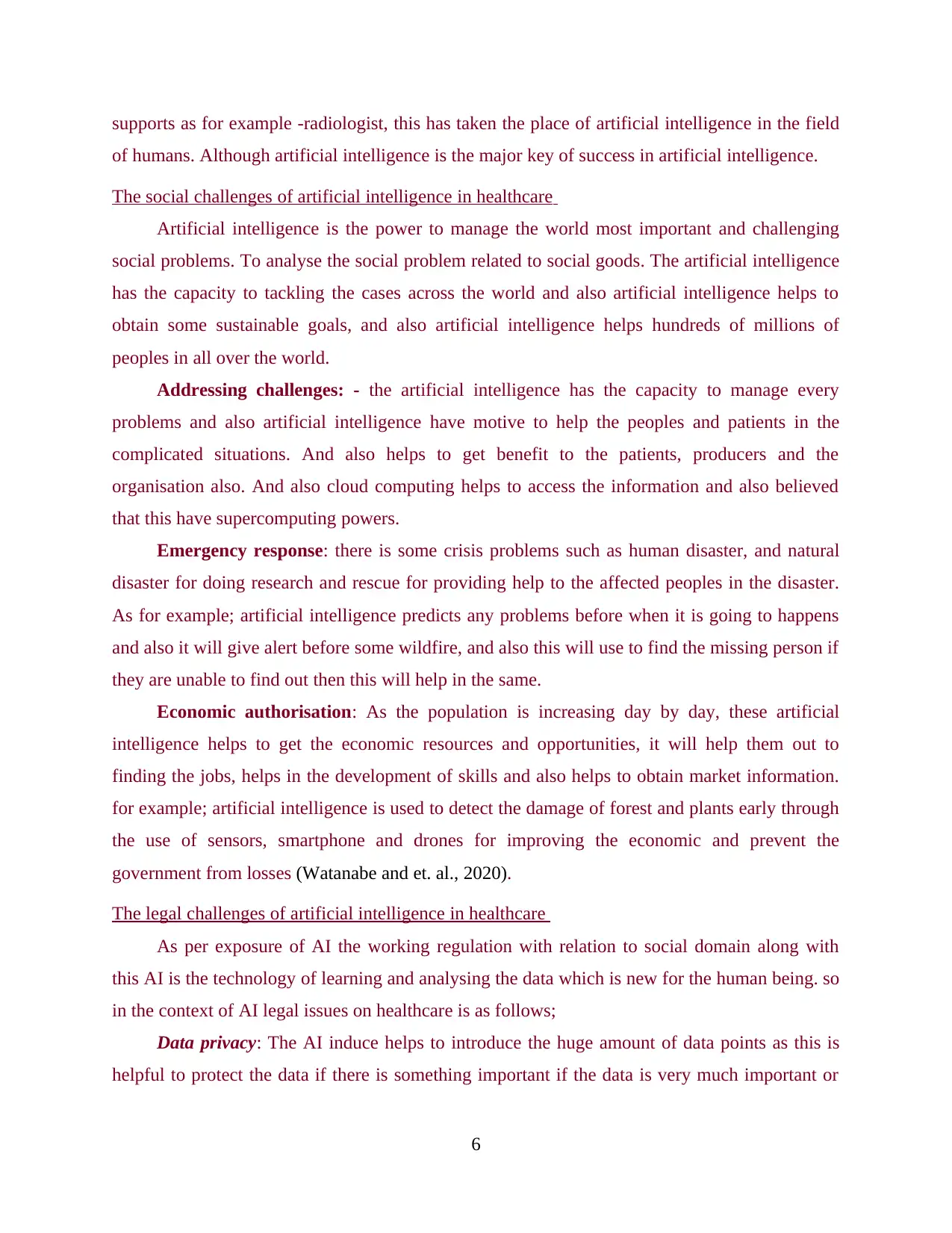
supports as for example -radiologist, this has taken the place of artificial intelligence in the field
of humans. Although artificial intelligence is the major key of success in artificial intelligence.
The social challenges of artificial intelligence in healthcare
Artificial intelligence is the power to manage the world most important and challenging
social problems. To analyse the social problem related to social goods. The artificial intelligence
has the capacity to tackling the cases across the world and also artificial intelligence helps to
obtain some sustainable goals, and also artificial intelligence helps hundreds of millions of
peoples in all over the world.
Addressing challenges: - the artificial intelligence has the capacity to manage every
problems and also artificial intelligence have motive to help the peoples and patients in the
complicated situations. And also helps to get benefit to the patients, producers and the
organisation also. And also cloud computing helps to access the information and also believed
that this have supercomputing powers.
Emergency response: there is some crisis problems such as human disaster, and natural
disaster for doing research and rescue for providing help to the affected peoples in the disaster.
As for example; artificial intelligence predicts any problems before when it is going to happens
and also it will give alert before some wildfire, and also this will use to find the missing person if
they are unable to find out then this will help in the same.
Economic authorisation: As the population is increasing day by day, these artificial
intelligence helps to get the economic resources and opportunities, it will help them out to
finding the jobs, helps in the development of skills and also helps to obtain market information.
for example; artificial intelligence is used to detect the damage of forest and plants early through
the use of sensors, smartphone and drones for improving the economic and prevent the
government from losses (Watanabe and et. al., 2020).
The legal challenges of artificial intelligence in healthcare
As per exposure of AI the working regulation with relation to social domain along with
this AI is the technology of learning and analysing the data which is new for the human being. so
in the context of AI legal issues on healthcare is as follows;
Data privacy: The AI induce helps to introduce the huge amount of data points as this is
helpful to protect the data if there is something important if the data is very much important or
6
of humans. Although artificial intelligence is the major key of success in artificial intelligence.
The social challenges of artificial intelligence in healthcare
Artificial intelligence is the power to manage the world most important and challenging
social problems. To analyse the social problem related to social goods. The artificial intelligence
has the capacity to tackling the cases across the world and also artificial intelligence helps to
obtain some sustainable goals, and also artificial intelligence helps hundreds of millions of
peoples in all over the world.
Addressing challenges: - the artificial intelligence has the capacity to manage every
problems and also artificial intelligence have motive to help the peoples and patients in the
complicated situations. And also helps to get benefit to the patients, producers and the
organisation also. And also cloud computing helps to access the information and also believed
that this have supercomputing powers.
Emergency response: there is some crisis problems such as human disaster, and natural
disaster for doing research and rescue for providing help to the affected peoples in the disaster.
As for example; artificial intelligence predicts any problems before when it is going to happens
and also it will give alert before some wildfire, and also this will use to find the missing person if
they are unable to find out then this will help in the same.
Economic authorisation: As the population is increasing day by day, these artificial
intelligence helps to get the economic resources and opportunities, it will help them out to
finding the jobs, helps in the development of skills and also helps to obtain market information.
for example; artificial intelligence is used to detect the damage of forest and plants early through
the use of sensors, smartphone and drones for improving the economic and prevent the
government from losses (Watanabe and et. al., 2020).
The legal challenges of artificial intelligence in healthcare
As per exposure of AI the working regulation with relation to social domain along with
this AI is the technology of learning and analysing the data which is new for the human being. so
in the context of AI legal issues on healthcare is as follows;
Data privacy: The AI induce helps to introduce the huge amount of data points as this is
helpful to protect the data if there is something important if the data is very much important or
6
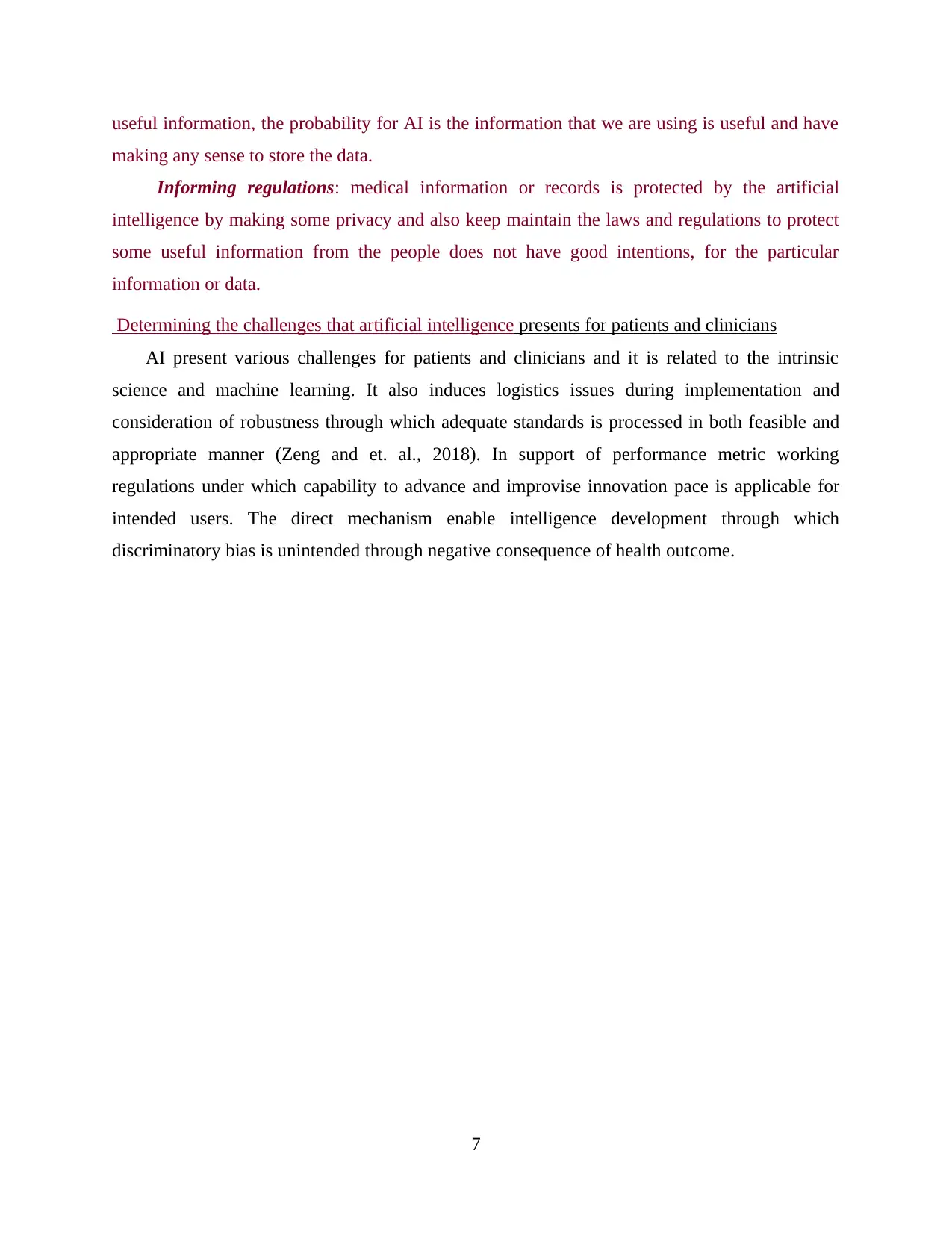
useful information, the probability for AI is the information that we are using is useful and have
making any sense to store the data.
Informing regulations: medical information or records is protected by the artificial
intelligence by making some privacy and also keep maintain the laws and regulations to protect
some useful information from the people does not have good intentions, for the particular
information or data.
Determining the challenges that artificial intelligence presents for patients and clinicians
AI present various challenges for patients and clinicians and it is related to the intrinsic
science and machine learning. It also induces logistics issues during implementation and
consideration of robustness through which adequate standards is processed in both feasible and
appropriate manner (Zeng and et. al., 2018). In support of performance metric working
regulations under which capability to advance and improvise innovation pace is applicable for
intended users. The direct mechanism enable intelligence development through which
discriminatory bias is unintended through negative consequence of health outcome.
7
making any sense to store the data.
Informing regulations: medical information or records is protected by the artificial
intelligence by making some privacy and also keep maintain the laws and regulations to protect
some useful information from the people does not have good intentions, for the particular
information or data.
Determining the challenges that artificial intelligence presents for patients and clinicians
AI present various challenges for patients and clinicians and it is related to the intrinsic
science and machine learning. It also induces logistics issues during implementation and
consideration of robustness through which adequate standards is processed in both feasible and
appropriate manner (Zeng and et. al., 2018). In support of performance metric working
regulations under which capability to advance and improvise innovation pace is applicable for
intended users. The direct mechanism enable intelligence development through which
discriminatory bias is unintended through negative consequence of health outcome.
7
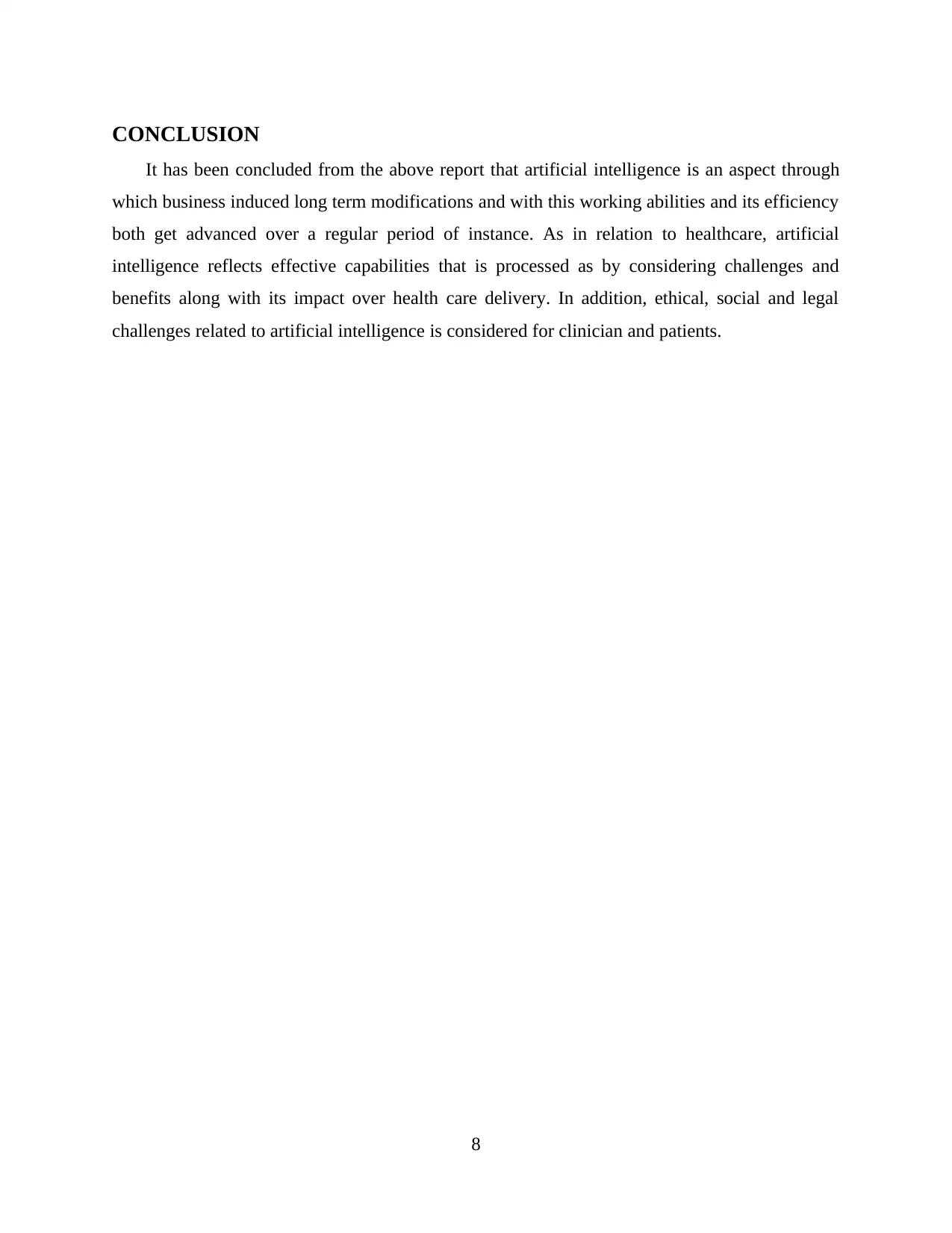
CONCLUSION
It has been concluded from the above report that artificial intelligence is an aspect through
which business induced long term modifications and with this working abilities and its efficiency
both get advanced over a regular period of instance. As in relation to healthcare, artificial
intelligence reflects effective capabilities that is processed as by considering challenges and
benefits along with its impact over health care delivery. In addition, ethical, social and legal
challenges related to artificial intelligence is considered for clinician and patients.
8
It has been concluded from the above report that artificial intelligence is an aspect through
which business induced long term modifications and with this working abilities and its efficiency
both get advanced over a regular period of instance. As in relation to healthcare, artificial
intelligence reflects effective capabilities that is processed as by considering challenges and
benefits along with its impact over health care delivery. In addition, ethical, social and legal
challenges related to artificial intelligence is considered for clinician and patients.
8
Secure Best Marks with AI Grader
Need help grading? Try our AI Grader for instant feedback on your assignments.
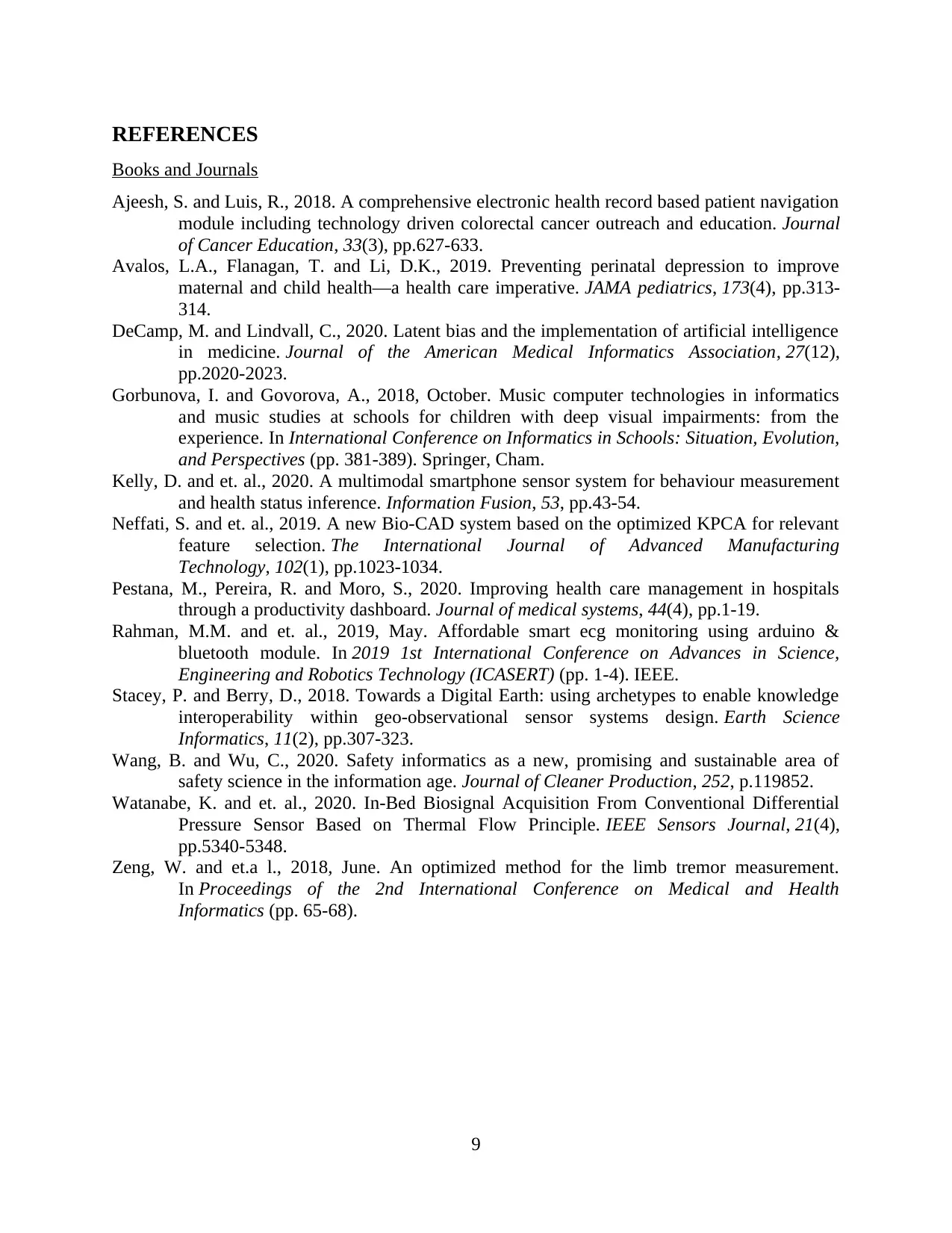
REFERENCES
Books and Journals
Ajeesh, S. and Luis, R., 2018. A comprehensive electronic health record based patient navigation
module including technology driven colorectal cancer outreach and education. Journal
of Cancer Education, 33(3), pp.627-633.
Avalos, L.A., Flanagan, T. and Li, D.K., 2019. Preventing perinatal depression to improve
maternal and child health—a health care imperative. JAMA pediatrics, 173(4), pp.313-
314.
DeCamp, M. and Lindvall, C., 2020. Latent bias and the implementation of artificial intelligence
in medicine. Journal of the American Medical Informatics Association, 27(12),
pp.2020-2023.
Gorbunovа, I. and Govorova, A., 2018, October. Music computer technologies in informatics
and music studies at schools for children with deep visual impairments: from the
experience. In International Conference on Informatics in Schools: Situation, Evolution,
and Perspectives (pp. 381-389). Springer, Cham.
Kelly, D. and et. al., 2020. A multimodal smartphone sensor system for behaviour measurement
and health status inference. Information Fusion, 53, pp.43-54.
Neffati, S. and et. al., 2019. A new Bio-CAD system based on the optimized KPCA for relevant
feature selection. The International Journal of Advanced Manufacturing
Technology, 102(1), pp.1023-1034.
Pestana, M., Pereira, R. and Moro, S., 2020. Improving health care management in hospitals
through a productivity dashboard. Journal of medical systems, 44(4), pp.1-19.
Rahman, M.M. and et. al., 2019, May. Affordable smart ecg monitoring using arduino &
bluetooth module. In 2019 1st International Conference on Advances in Science,
Engineering and Robotics Technology (ICASERT) (pp. 1-4). IEEE.
Stacey, P. and Berry, D., 2018. Towards a Digital Earth: using archetypes to enable knowledge
interoperability within geo-observational sensor systems design. Earth Science
Informatics, 11(2), pp.307-323.
Wang, B. and Wu, C., 2020. Safety informatics as a new, promising and sustainable area of
safety science in the information age. Journal of Cleaner Production, 252, p.119852.
Watanabe, K. and et. al., 2020. In-Bed Biosignal Acquisition From Conventional Differential
Pressure Sensor Based on Thermal Flow Principle. IEEE Sensors Journal, 21(4),
pp.5340-5348.
Zeng, W. and et.a l., 2018, June. An optimized method for the limb tremor measurement.
In Proceedings of the 2nd International Conference on Medical and Health
Informatics (pp. 65-68).
9
Books and Journals
Ajeesh, S. and Luis, R., 2018. A comprehensive electronic health record based patient navigation
module including technology driven colorectal cancer outreach and education. Journal
of Cancer Education, 33(3), pp.627-633.
Avalos, L.A., Flanagan, T. and Li, D.K., 2019. Preventing perinatal depression to improve
maternal and child health—a health care imperative. JAMA pediatrics, 173(4), pp.313-
314.
DeCamp, M. and Lindvall, C., 2020. Latent bias and the implementation of artificial intelligence
in medicine. Journal of the American Medical Informatics Association, 27(12),
pp.2020-2023.
Gorbunovа, I. and Govorova, A., 2018, October. Music computer technologies in informatics
and music studies at schools for children with deep visual impairments: from the
experience. In International Conference on Informatics in Schools: Situation, Evolution,
and Perspectives (pp. 381-389). Springer, Cham.
Kelly, D. and et. al., 2020. A multimodal smartphone sensor system for behaviour measurement
and health status inference. Information Fusion, 53, pp.43-54.
Neffati, S. and et. al., 2019. A new Bio-CAD system based on the optimized KPCA for relevant
feature selection. The International Journal of Advanced Manufacturing
Technology, 102(1), pp.1023-1034.
Pestana, M., Pereira, R. and Moro, S., 2020. Improving health care management in hospitals
through a productivity dashboard. Journal of medical systems, 44(4), pp.1-19.
Rahman, M.M. and et. al., 2019, May. Affordable smart ecg monitoring using arduino &
bluetooth module. In 2019 1st International Conference on Advances in Science,
Engineering and Robotics Technology (ICASERT) (pp. 1-4). IEEE.
Stacey, P. and Berry, D., 2018. Towards a Digital Earth: using archetypes to enable knowledge
interoperability within geo-observational sensor systems design. Earth Science
Informatics, 11(2), pp.307-323.
Wang, B. and Wu, C., 2020. Safety informatics as a new, promising and sustainable area of
safety science in the information age. Journal of Cleaner Production, 252, p.119852.
Watanabe, K. and et. al., 2020. In-Bed Biosignal Acquisition From Conventional Differential
Pressure Sensor Based on Thermal Flow Principle. IEEE Sensors Journal, 21(4),
pp.5340-5348.
Zeng, W. and et.a l., 2018, June. An optimized method for the limb tremor measurement.
In Proceedings of the 2nd International Conference on Medical and Health
Informatics (pp. 65-68).
9
1 out of 11
Related Documents
Your All-in-One AI-Powered Toolkit for Academic Success.
+13062052269
info@desklib.com
Available 24*7 on WhatsApp / Email
![[object Object]](/_next/static/media/star-bottom.7253800d.svg)
Unlock your academic potential
© 2024 | Zucol Services PVT LTD | All rights reserved.





